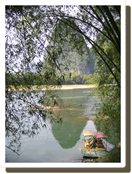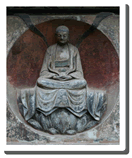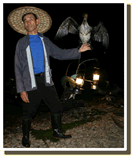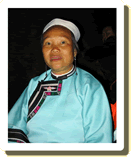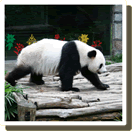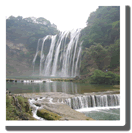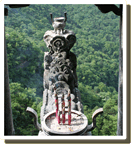Video clips from the trip to China.
 Note: These video clips are hosted at Youtube.com which is very popular and very reliable web site, however if their server is down for whatever reason you may not be able to see the video clips. Probably such events will be rare.
Note: These video clips are hosted at Youtube.com which is very popular and very reliable web site, however if their server is down for whatever reason you may not be able to see the video clips. Probably such events will be rare.
In order to see the clips you have to have JavaScript active in your browser; most people do not disable JavaScript in their browsers and chances are your browser is set properly, I mentioned that just in case. When you click on the icon link a new layer will appear and the clip will play in that new layer.
For more video clips check out Bulletin Board. You can also post links to interesting (China related) video clips or share your own video material with other travelers. (At the bulletin board you can also find the list of web site where you can upload (for free) your pictures and video files!).
Down Yulong River and Li River on the bamboo raft.
Y├Īngshu├▓ is a small town just 65km south of Gu├¼l├Łn (in Province).
Y├Īngshu├▓ has almost legendary status among western backpackers. ItŌĆÖs a very small town with practically only two big streets and many tourists find a base in Y├Īngshu├▓ while exploring the picturesque countryside.
Limestone hills and two rivers are making that part of southern China tourist magnet; L├Ł Ji─üng or L├Ł River runs between Gu├¼l├Łn and Y├Īngshu├▓ and many western tourist take a boat ride down Li River from Gu├¼l├Łn to Y├Īngshu├▓ and pay approximately $100 for that pleasure (Chinese tourists pay less that half of that so if you speak Chinese or donŌĆÖt really care what the tourist guide is saying then join the Chinese tour group).
If you prefer doing things on your own you can take a bus to Y├Īngd─½ (Y6 in 2007) and find some of those entrepreneurial Chinese with motor powered bamboo rafts who will take you and your friend from Y├Īngd─½ to X─½ngp├Łng (which is approximately one hour trip through the most scenic parts of L├Ł River) for Y80 each (total Y160, thatŌĆÖs how much I paid in 2007). It is worth mentioning that they donŌĆÖt care if you can or can not swim, no life jackets are provided (it is assumed that you would not sit on the raft if you can not swim) so ask if the drowning is included in the package.
The second, less famous river is called Y├╣l├│ng H├® or Y├╣l├│ng River which means Jade Dragon River (donŌĆÖt ask me why Chinese have two different words for river: ŌĆ£H├®ŌĆØ and ŌĆ£Ji─üngŌĆØ; I donŌĆÖt know but I assume ŌĆ£Ji─üngŌĆØ rivers are bigger than ŌĆ£H├®ŌĆØ rivers).
When you mount your bike in Y├Īngshu├▓ head towards Yu├©li├ ng Sh─ün Area (Moon Hill) around 20-30 minutes later, just before you hit the Big Banyan Tree spot (the tree is said to be 1500 years old!) you will cross the bridge over Y├╣l├│ng River. Even though it is not as famous as L├Ł River, Y├╣l├│ng River is, in my opinion, more beautiful.
This video clip was recorded early in the morning, around 7AM, when there were no other tourists around (thatŌĆÖs another thing you will notice about Y├Īngshu├▓, both tourists and local people wake up around 9AM after partying hard the night before). The river was so calm it was reflecting the surrounding hills like a perfect mirror. Get up early if you want to take a ride on a bamboo raft because after 10AM the river will be full of tourist on all sorts of floating objects.
You can spend the whole one day walking or biking along Y├╣l├│ng River because there is a 12km pathway which will take you through small hamlets, over some old-style bridges and into a couple of traditional villages.
Biking through the countryside around Yangshuo.
Y├Īngshu├▓ itself is not a very interesting place; all interesting sites are scattered in the vicinity of the town; caves, hills, riversŌĆ”
For only Y10 (in 2007) you can rent a bike and explore the surrounding countryside in one or two days. However I would strongly recommend that you donŌĆÖt do that on your own; go with at least one more person or even better, a group of 4-5 tourist should hire a local guide. Y├Īngshu├▓ was the only place I visited in China where I did not feel very safe; it may have something to do with the fact that a foreign tourist got killed at the Moon Hill a couple of years ago but there are definitely some ŌĆ£bad vibrationsŌĆØ in the air in Y├Īngshu├▓ and one can never be too cautious.
Another reason why you should have a local guide when you decide to bike around Y├Īngshu├▓ is that the maps that you can buy in the town are not detailed enough in order to navigate your way around. You will easily get lost. Even our guide, a local person, the lady who ran the hotel where we stayed, had to ask for directions several times.
We headed towards F├║l├¼ Village first and that part was very interesting because we biked along the Li River and finally crossed the river on the boat and entered F├║l├¼ Village. The village itself was a disappointment; nothing special about it; stores selling painted fans, Chinese calligraphy and knick-knacks to tourists, ordinary housesŌĆ” We did not spend much time there.
After Fúlì Village we headed towards the Moon Hill, however that was around noon and I forgot to put the sunscreen on so I earned some heavy-duty sunburns (it was mid April).
The video clips that you can see here are recorded while I was riding my bike towards Fúlì Village and on the way back (no, I did not fall off the bike in the process).
Li River Cormorant Fishing.
Fishermen on the Li River (µ╝ōµ▒¤) traditionally used cormorants for fishing; of course these were tamed cormorants that were specially trained to "work" with the fishermen.
When the fisherman sees that they have fish in their throat (or beak) he scoops them up with a special rod and then takes (somehow) fish from the birdsŌĆÖ mouth and puts it in the basket, then releases the bird which happily dives again trying to catch another fish.
When I was reading about it before the trip I thought that those birds were tied to the bamboo raft but in fact they are totally free however they are trained to do what they do and they completely obey fishermanŌĆÖs commands. Nowadays they are mostly tourist attraction because fishermen make more money by doing fake fishing trips than the real ones.
It costs around Y30-Y40 to get on the boat and watch that performance on the Li River in Yangshuo. The boat departs around 7PM from the dock at the end of Xi Jie.
There were around 10 tourists in the cabin on the boat, sitting on two benches next to the sliding windows. If you pick the right side of the boat you will be able to open the window and take some photos through the window because the bamboo raft and the fisherman with his cormorants will be around 10m away from your boat. Those pictures are usually not very good because itŌĆÖs too dark and the boat is too shaky for long exposition photos.
First you will go down the river then the raft and the boat will take a turn and return to the departing point. Before they return they will take you to the other side of the river where the fisherman will demonstrate how he takes fish from the cormorantsŌĆÖ throats.
I apologize for the very bad quality of these video clips but this is just a little bit better than nothing I guess.
Chinese Panda in Guilin's "Seven Stars Park".
Gu├¼l├Łn is a much bigger place than Y├Īngshu├▓; itŌĆÖs a real city of 1.3 million people while Y├Īngshu├▓ is a town.
Guilin has been a famous tourist destination for many Chinese for a long time. Guilin, as opposed to Y├Īngshu├▓, has some urban charm and you can find interesting places within the city itself whereas in Y├Īngshu├▓ you will have to explore the area around the town. There are several parks in Guilin, one of them is called ŌĆ£Seven Star ParkŌĆØ and because itŌĆÖs across the Li River usually itŌĆÖs not crowded with tourists as those parks on the right bank of the Li River.
This Panda is one of the several interesting animals in the park.
Did you know that Chinese word for panda is ńåŖńī½ (xi├│ngm─üo) which means ŌĆ£Bear-catŌĆØ?
Terraced hills around Ping'an Village.
Just 3-4 hours by bus from Gu├¼l├Łn there is an area and a city called L├│ngsh├©ng where several minority groups live: Zhuang, Yao, Miao and Dong national minorities.
Very close to L├│ngsh├©ng there are several interesting looking hills called (ķŠÖĶäŖµó»ńö░) which means Backbone of the Dragon Teraces, which are basically perfectly terraced rice paddies.
Probably the most popular village for exploring terraced fields in the area is called PingŌĆÖan Village which is home to Zhuang people. ItŌĆÖs a very lovely village which usually serves as a base for exploring nearby sites.
In order to get to PingŌĆÖan you donŌĆÖt have to go all the way to L├│ngsh├©ng, you can get off the bus in the town called H├®p├Łng which is 83km away from Gu├¼l├Łn and the bus has to go another 13km before it arrives in L├│ngsh├©ng. ThatŌĆÖs what I did when I went to PingŌĆÖan in April of 2007.
Immediately after me and another 2-3 tourists got off the bus a person who drove a minibus approached us and offered a ride to PingŌĆÖan village, the price was Y50 per person, after we flatly turned down his offer he followed us while we walked 100-200m back to the point which looked like a bus stop and at that time the same driver agreed to take us to PingŌĆÖan village for Y15 per person (for four persons).
If you decide to walk from Heping to PingŌĆÖan it will take more than 3 hours even if you donŌĆÖt carry any luggage. I would not recommend that; probably the best plan is to find a room in PingŌĆÖan first, drop off the stuff that you donŌĆÖt need and start trekking along the ŌĆ£dragonŌĆÖs backboneŌĆØ the following day.
This video clip was recorded on the hill just above PingŌĆÖan village
DonŌĆÖt forget to take a smoke detector with you when you go to PingŌĆÖan because the whole village is built of pinewood and I did not see any fire extinguishers around!
Huangshan - the majestic mountain!
Hu├Īngsh─ün (ķ╗äÕ▒▒) or Yellow Mountain is probably the most beautiful mountain in China and for most Chinese this mountain and Guilin limestone hills are the most attractive nature scenery in China.
This mountain has not been discovered by the western tourists yet (2007) but very soon it may become as popular as Guilin and Yangshuo because of its stunning beauty and its easy access from Shanghai.
If you arrive to Huangshan by bus then there is no need to go to Huangshan City, the bus will drop you off in Tangkou.
The elevation of Huangshan is 1873m and it has 72 peaks. You donŌĆÖt need a guide because the paths are clearly marked and there are tons of other (Chinese) tourists around so you wonŌĆÖt get lost even if you donŌĆÖt pay attention to signage.
Realistically, you will need at least 2-3 days on the mountain to enjoy the beautiful vistas and if you are lucky you will witness the scenes of the mountain peaks sticking through the sea of clouds which is frequently depicted in Chinese paintings.
Also there is no need to climb the mountain or walk all the way down to the beginning of the trail because you can take cable car up and down. The most interesting and the most beautiful parts of the mountain are on the top of the mountain, you wonŌĆÖt miss anything if you take a cable car however you will need every atom of your energy for endless walking from one peak to another.
This video clip was taken at the spot called ŌĆ£Gazing MonkeyŌĆØ which is just 100-200m from Beihai Hotel which is probably the most famous hotel on the mountain.
For budget travelers I recommend a hostel behind the Xihai Hotel, just underneath a small dam. ThatŌĆÖs probably the least expensive option.
The biggest waterfall in China and Longgong Cave.
Hu├ĪngguŪÆsh├╣ D├ P├╣b├╣ is Gu├¼zh┼Źu ProvinceŌĆÖs number one tourist attraction.
The waterfall is 81m wide and 74m high and it is one massive waterfall especially during the rainy season (from May to October), 4-5 days after a heavy rain. There are around 18 other smaller waterfalls in the area. The nearest big city is ─Ćnsh├╣n however if you stay in Gu├¼y├Īng you can easily get there by bus, it takes around 3 hours to get to the waterfall.
The buses depart in front of the train station in Gu├¼y├Īng, however not exactly from the main bus terminal, which is located to the left, the waterfall buses are lined up on the right side of the main street (Zunyi Lu) which starts practically at the entrance to the train station.
Look for the ķ╗äµ×£µ æ signs behind the busŌĆÖ windshield.
I stayed in Gu├¼y├Īng 4 days and visited Huangguoshu Waterfall and L├│ngg┼Źng Caves in one day, another day I explored Gu├¼y├Īng and the last day I continued my trip to K├║nm─½ng by air.
You can visit both Huangguoshu Waterfall and Longgong Caves in one day but it will be a pretty hectic day; I departed from Guiyang around 7AM, arrived at the waterfall around 10:30AM, had a quick breakfast and spent around 2 hours in the waterfall area.
When you walk down to the Rhinoceros Pool and take a couple of pictures there is nothing else to do except to walk over a suspension bridge and go to the ŌĆ£Water Curtain CaveŌĆØ which basically means you will walk underneath the waterfall through the narrow cave which is approximately at the middle point between the top and bottom of the waterfall.
People walk both ways so if you are over 190cm tall like myself you may have hard time getting through the cave because itŌĆÖs very narrow, wet and the ceiling is low. Every now and then you will come across an opening in the cave wall with a view from the cave through the curtain of water falling from the top, which is pretty neat.
Around 12:30 I took a taxi from Huangguoshu to Longgong Caves because the minibuses were cheaper however you never know when they depart because they wait until they get enough passengers onboard so it may take a while for that to happen.
Since I wanted to be in Guiyang by 6PM, and I knew that the last bus departed from Anshun at 5PM I did not have time for wasting. Longong caves are closer to Anshun than the Waterfall so I was heading back towards Anshun. It took almost one hour to arrive at the entrance gate of the Longgong Caves area.
I walked down to the place which looked like a beginning of the route, I sat in the boat which took me to a place near a small village and based only on the information printed on the map on my ticket I could not figure out where the caves were.
One of the local guys in that village realized I was sort of lost so he offered to be my guide for Y50 and since I did not have that much time (it was around 2:00Pm by that time) I agreed, so he took me back to the place where I got off the boat, we took a minibus (Y3) which took us back through the entrance point (where I bought my ticket) and drove to another entrance which was 5-10 minutes by bus from the main entrance, there was a small village there too, and we got into a boat and entered the main cave, and after that the second one.
The guide was extremely helpful and after I told him I didnŌĆÖt want to see the rest of the spots he took me back using the same boats which were returning to the departure point so it was practically only him, me and the person who was paddling, in the boat.
He took me back to the small village where we got off the first minibus and we found another minibus going to Anshun and almost one hour later I was in Anshun, just in time to take another bus to Guiyang.
The first two video clips are from the Huangguoshu waterfall, the third one was taken in the boat just before we entered the main cave at Longgong Cave.
Pedicab ride through Dazu.
Chóngqìng is a big city in South-west China.
In 1997 Ch├│ngq├¼ng became a ŌĆ£special municipalityŌĆØ which means that it did not belong to the S├¼chu─ün Province any more, at least when it comes to economy and money matters.
ItŌĆÖs not very touristy place because most western (and also Chinese, I guess) tourists who come to Chongqing go there only because that is the departing point for most Yangzi River cruises, taking tourists through the Three Gorges area.
Around 90km west of Ch├│ngq├¼ng is the town of D├ z├║ where you can see some of the most famous examples of Chinese Buddhist cave sculptures and cave art (other locations where you can find famous Buddhist cave sculptures are Lu├▓y├Īng, D┼½nhu├Īng and D├ t├│ng).
Please note there is another town further away to the north of Ch├│ngq├¼ng, which is called D├ zh├║ , so you donŌĆÖt want end up there only because of your bad pronunciation. ŌĆ£ZŌĆØ in ŌĆ£D├ z├║ŌĆØ is pronounced as ŌĆ£dsŌĆØ in ŌĆ£beadsŌĆØ and ŌĆ£zhŌĆØ in ŌĆ£D├ zh├║ŌĆØ like ŌĆ£juŌĆØ in ŌĆ£juiceŌĆØ.
First bus departs from the ChongqingŌĆÖs long distance bus station (Caiyuanba), at 6:00AM and it takes 2-3 hours to get to the bus station in Dazu.
From there you will have to take a pedicab or taxi from to the spot where you can take a minibus which will take you to BŪÄodŪÉng Sh─ün which is 15km north-east of Dazu town.
Baoding Shan is where the most beautiful of almost 50 000 Dazu clifftop Buddhist carvings (Õż¦ĶČ│ń¤│Õł╗, D├ z├║ sh├Łk├©) can be found. It is believed that it took 70 years to finish the sculptures, from 1179 to 1249. You will need no more than 2-3hours to see all of them (at this particular spot) just by walking along the horse-shoe shaped pathway.
This video clip was taken when I was on the pedicab taking me from the bus station to the place where I boarded a minibus to Baoding Shan.
Did you know that Ch├│ngq├¼ng, and N├Īnj─½ng are called ŌĆ£the three furnaces of ChinaŌĆØ because the summer temperatures in those cities often exceed 40 C?
Stone forest (Shilin) near Kunming.
K┼½nm├Łng is a city in Y├║nn├Īn province.
This is south-western China, close to Vietnam and Tibet. Yunnan is the home of 1/3of all Chinese national minorities, the most varied province in terms of climate and terrain.
Kunming is the city also known as ŌĆ£the Spring CityŌĆØ because of its year-round mild climate. The secret wish of many Chinese is to live (or at least to retire) in Y├║nn├Īn province. The easiest way to get to Kunming is by air.
L├╣n├Īn Sh├Łl├Łn is located around 100km south-east of Kunming (in Lunan Yi /ÕĮØ/ Autonomous County).
Buses depart from the bus station next to the train station, the one I took departed at 8:00AM.
The Stone Forest is one big maze of grey limestone pillars, some 30m high, shaped by wind and rain over the course of over 200 million years.
There are several ŌĆ£stone forestsŌĆØ in south-western China but this one is probably the most impressive. You may hire a guide who will take you through the endless maze of pathways among the grey rocks and point to the funny shapes which they interpret as buffalos, elephants, tortoiseŌĆ” You can see pretty much anything if you look hard and long enough.
If you leave Kunming at 8:00AM, you should be at Stone Forest around 10AM, you need no more than 3 hours to roam around and around 1:00 PM you can take a bus back to Kunming and have a late lunch there. Kunming food is extremely tasty and sometimes extremely hot!
These video clips are recorded in April of 2007.
Wudangshan Dragon (and wushu school).
WŪöd─üng Sh─ün is a mountain range stretching over 400km across north-western H├║b─øi province, between Xiangfan and Shiyan.
Wudangshan is one of the most sacred Daoist mountains also famous for itŌĆÖs unique style of martial arts developed by Daoist monks.
Probably the most famous Wudangshan Daoist monk (at least to the westerners) was Zhang San Feng who is believed to be the inventor of t├ ij├Łqu├Īn , or tai chi (he lived in the 13th or 14th century). There are many martial arts schools at the mountain and in the town, with many western students.
I arrived in Wudangshan City on the train from (µŁ”µ▒ē); the train departed at 9:00AM and I arrived in Wudangshan city around 2:30 PM.
The entrance to the mountain is not far from the train station. Very comfortable buses will take you from the entrance point practically to any point on the mountain, except to the very top because buses can not get there (you have to walk or take a cable car).
The top of the mountain is 25km far from the entrance gate. The bus transportation on the mountain is included in the price of the ticket (almost Y200 in 2007) so you can move from one point to another with no problem.
I spent 5-6 days on the mountain; three days close to the ŌĆ£South CragŌĆØ parking area and the second three days at the top of the mountain.
The first video clip I took at the top of the mountain; the scene was surreal; I was standing on the cliff behind the main temple area and an incredible scene was playing out in front of my eyes: the immense amount of clouds were rushing from the valley from the right while at the same time the left hand side of the sky was completely clear of any clouds or even mist. Those two air streams were colliding right in front of me, maybe 100-200m away from the spot where I was standing.
The white clouds were swirling towards the sky in one almost alive column. That was probably the closest I ever got to the one real Chinese dragon.
The video clip is the recording of that event but because of the sheer size of the space I just described what you can see is not doing justice to the beauty and mystery of the event.
The second video clip is the recording of the practice in one of the martial arts schools down in Wudangshan city (recorded in April 2007).
Wudangshan has extremely strong yang energy (the only other place where I felt the same surge of energy was at T├ i Sh─ün, µ│░Õ▒▒).
Shanghai - Nanjing Road.
Sh├ nghŪÄi with its population of over 16 million people (and growing) is a real 21st century metropolis.
European colonists used to call Shanghai ŌĆ£Paris of the EastŌĆØ and many consider it to be the financial and economic heart of China and the most free-spirited city in China.
Shanghai is much much different than any other place I have seen in China.
Soon after China allowed more economic freedom in the mid eighties Shanghai took off on the wave of free-market economy. Especially after the decision was made in 1990 that , the eastern side of Hu├ĪngpŪö Ji─üng should be developed.
ItŌĆÖs an overcrowded fast paced environment where you can find people from all walks of life; both those rich beyond measure and scores of itinerant workers just trying to earn enough to feed their families somewhere in the rural parts of China.
When in Shanghai try to find some time for visiting some of the famous ancient Chinese water towns!
First video clip is of the most fashionable street in Shanghao, Nanjing Lu. The second video clip was recorded in the main hall of the Shanghai Museum.
